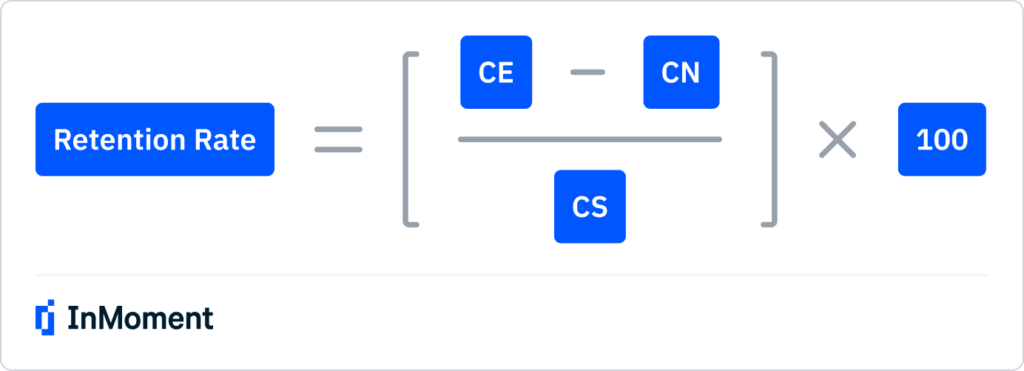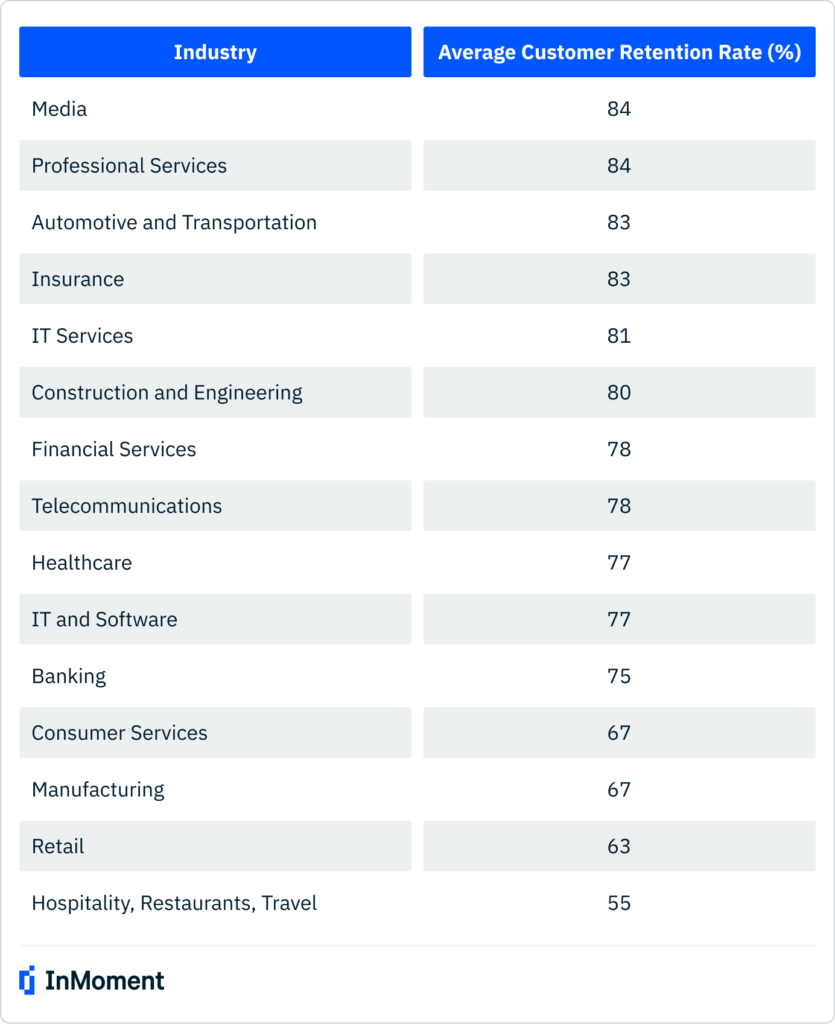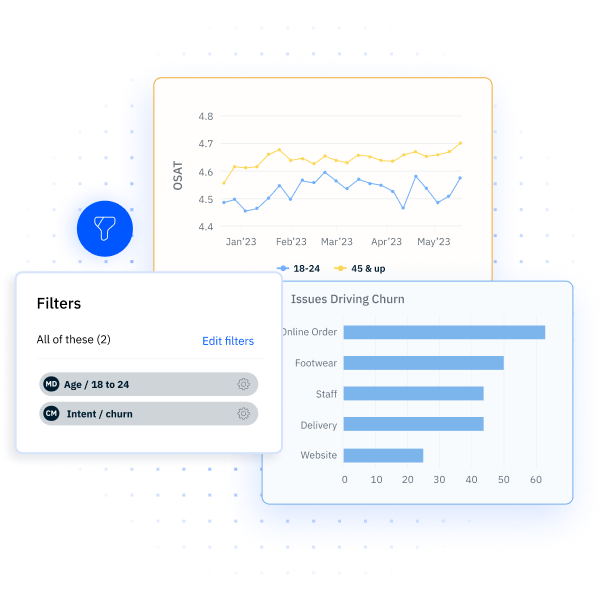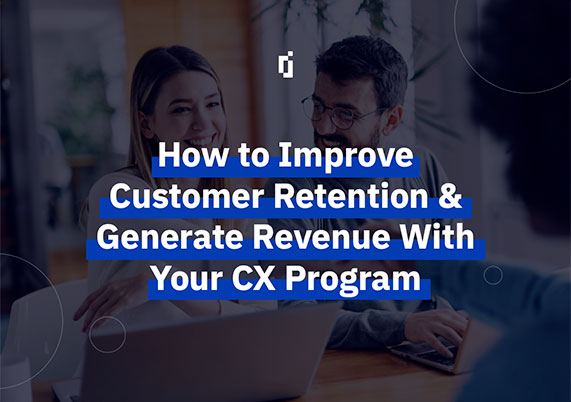How Customer Retention Strategies Can Facilitate Business Growth
Customer retention measures the ability of your organization to keep existing customers. Tracking and improving customer retention will help you drive revenue growth and enhance customer loyalty.
Did you know that customer acquisition costs have risen by over 200% over the last 10 years? It is increasingly expensive and difficult to improve customer acquisition, which means that it is just as important to keep your current customers happy. Focusing on customer retention will help your organization reduce costs and increase revenue.
What Is Customer Retention?
Customer retention is your organization’s ability to keep your existing customers coming back to you over a set period. This is a key indicator of your organization’s customer loyalty and success in building lasting customer relationships.
Why is Customer Retention Important?
High customer retention rates indicate high customer satisfaction, which leads to repeat business and increased word-of-mouth referrals. Customer retention is important because the longer a customer stays with your brand, the higher their average purchase is. Also, the top 10% of customers spend more than the other 90%. Keeping customers will increase your average customer lifetime value, and help create a sustainable business model.
How Is Customer Retention Measured?
Your customer retention rate is an important metric. To calculate it, you will first need to decide the period for which you will calculate it. For example, 97% of businesses calculate their customer retention rate at least once a year, with 71% of those businesses reviewing their customer retention rate monthly or weekly. To calculate customer retention, assume the following definitions:
- CE = The total # of customers when the period ends
- CN = The total # of new customers that you acquired during the period
- CS = The total # of customers at the beginning of a period
To calculate your retention rate, you need to use the following equation:

What is A Good Customer Retention Rate?
Customer retention rates vary widely depending on the industry you operate in. That being said, knowing the average customer retention rate for your industry will help you benchmark against your competitors to see how your business compares. Here is the average customer retention rate by industry:

Customer Retention Strategies
Effective customer retention strategies are essential for fostering long-term customer relationships and producing a customer retention rate that rivals your competitors. While these strategies can vary based on your business model or resources available to your customer experience program, these proven strategies can help any organization reduce customer churn and improve customer retention.
1. Implement Loyalty Programs
Implementing a loyalty program can be one of the most effective customer retention strategies that your organization invests in. 79% of consumers say that loyalty programs caused them to purchase from an organization more frequently. By implementing a loyalty program that rewards customers for repeat purchases, such as discounts or early access to new products or services, you incentivize them to remain loyal to your organization.
2. Personalize Customer Experiences
Did you know that 71% of consumers expect a personalized customer experience? Furthermore, 78% of consumers are likely to repurchase from an organization that personalizes their customer experience.
Personalization helps create a deeper connection with customers by showing that your organization cares about their individual needs and preferences. When you personalize your customer experience, customers are more likely to make the initial purchase and more likely to return for future purchases, which will increase customer retention.
3. Seek Customer Feedback
In order to improve customer retention, you will need to solicit and respond to customer feedback. This makes customers feel more connected to your organization. As a matter of fact, 83% of customers agree that they are more loyal to organizations that respond to and resolve their complaints. To increase customer retention, make sure you have dedicated resources to responding to customers and identifying actionable insights from customer feedback.
With InMoment’s customer experience platform, you can not only respond to reviews, you can get actionable insights from that data. With InMoment’s AI-powered Active Listening solution, you can get 40% more actionable data points than similar platforms. This ensures you are getting the most out of your customer feedback.
4. Stay True to Your Brand
Consistency is key to building trust and loyalty with your customers. Ensure that your brand consistently delivers on its promises and that business decisions align with your core values. Research shows that 82% of consumers prefer a brand’s values to align with their own. By sticking to the core values of your business, you will attract customers with similar beliefs. By staying true to those values over time, you will build brand equity and easily retain those customers.
5. Improve Customer Experience Metrics
Another strategy to improve customer retention is by improving other customer experience metrics surrounding customer retention. For example, if you focus on eliminating the factors that are causing customer churn, you will eliminate the things causing customers to leave. As a result, you will retain more customers.

By implementing these customer retention strategies, you can build better customer relationships and build sustainable business growth. These strategies apply to all businesses, but customer retention strategies can be different for businesses in different industries looking to improve client retention, account retention, patient retention, and guest retention.
With InMoment’s platform, you can build a fully customized customer experience dashboard that contains the metrics that are most important to your business. These dashboards also allow you to build reports that are easily shareable with stakeholders in your organization, regardless of their having access to the platform. This makes it easy to share customer experience insights across the organization.
Client Retention Strategies
In service-based industries, retaining clients is critical for growth and getting referrals. Client retention is built upon strong relationships and trust. Implementing effective client retention strategies can help you improve client relationships and enhance profitability. Here are some strategies that can help improve client retention:
1. Build Personal Relationships
In the same way that customers want to have personal experiences with a brand, your clients want to have a personal relationship with your organization. You can personalize your interactions by remembering key details about their business and showing genuine interest in their success. Taking the time to schedule regular check-ins, personalize communication, and remember important dates such as client anniversaries will help strengthen personal relationships and improve client retention.
2. Offer Value-Added Services
You can realize more client retention by providing additional services or resources beyond the basic agreement the client has with your business. These additional items could include industry insights, training, or additional strategic advice. Offering these services shows that you are invested in their success for the long term, not just the duration of their contract.
3. Create a Clear Onboarding Process
A clear, structured onboarding process helps new clients feel comfortable and ensures they have all the information they need to get started. A smooth onboarding process sets a positive tone for the relationship. On the other hand, almost 25% of client churn happens because of an ineffective onboarding process. By focusing on the onboarding process, you decrease the likelihood of early termination and increase the likelihood of client retention.
4. Foster A Partnership Mentality
You want your client to see you as a partner, not just a service provider. It is important to show clients that you value them and their time. When presenting plans or strategies, be sure to ask for their feedback and consider it when finalizing your proposed plans. This partnership mentality helps build trust and reinforces the value of your relationship.
5. Stay Relevant and Adaptable
Client needs evolve over time. It is important to stay current with market trends and be adaptable to changes. You don’t want your clients leaving for a competitor who offers more current services than you, so be sure to regularly update your services to meet new client demands and industry standards. Demonstrating your adaptability will improve client retention.
With InMoment as your partner, you will never fall behind. The XI platform has been named a leader in Gartner, IDC, and Forrester reports. As updates are made to the Integrated CX approach, clients are always the first to be updated with new upgrades and features.
Account Retention Strategies
Account retention is important for B2B businesses looking to improve the B2B customer experience. In these industries, the loss of a single account can significantly impact the bottom line. Implementing account retention strategies can help minimize churn and help drive growth. Here are some strategies that can enhance account retention:
1. Understand Account Needs and Goals
Understanding your account’s business objectives, challenges, and industry dynamics is important for setting up the account in the best way possible and delivering relevant solutions. 86% of B2B organizations are more likely to buy if companies understand their goals. By taking the time to understand them in the purchasing process, as well as conducting regular needs assessments, you can stay aligned with their goals and present offerings that add value.
2. Provide Dedicated Account Management
In order to keep account satisfaction levels high, assign dedicated account managers that serve as a single point of contact. These account managers can provide personalized service, respond to inquiries quickly, and gain a better understanding of the account’s needs.
With InMoment, you will always have access to the best resources. Our personnel have over 50 years of advisory and research experience across multiple industries. Furthermore, InMoment never outsources services. InMoment takes full accountability for CX program success for the lowest cost of ownership.
3. Identify and Address At-Risk Accounts Early
To increase account retention, you need to prevent account churn. You can implement predictive customer analytics to identify signs of dissatisfaction or disengagement, such as decreased platform usage or negative feedback. It is important to have a system in place to flag these accounts so that immediate action can be taken to keep them from churning.
4. Ensure Cross-Departmental Coordination
Improving account retention also requires internal work. Effective account management requires communication across multiple departments to ensure a cohesive experience. For example, if the account manager promotes a new feature to the client that won’t be ready for six months, this would cause frustration and might lead to churn. However, if the account managers are informed about the product development roadmap, they will know when it is appropriate to start promoting new products or features.
5. Offer Incentives and Rewards for Loyalty
Rewarding long-term accounts with special incentives can reinforce their loyalty. This could include discounts, priority access to new features or products, or invitations to exclusive events. Recognizing their loyalty shows that you value their business and encourages account retention.
Guest Retention Strategies
Guest retention is critical for businesses in the hospitality industry, such as hotels, restaurants, and entertainment venues. Working to improve the guest experience and encouraging them to return can lead to increased revenue, positive online reviews, and valuable word-of-mouth marketing. Here are some effective strategies for retaining guests and creating lasting impressions:
1. Personalize the Guest Experience
Personalization is especially important in the hospitality industry. It can make guests feel valued and create a memorable experience that often coincides with important occasions. Use guest data, such as past preferences and special requests, to tailor their stay or visit. Whether it’s a personalized greeting, a favorite room setup, or a preferred table in a restaurant, these small touches can make a big difference in the guest experience and increase the likelihood of guest retention.
2. Maintain An Omnichannel Experience
An omnichannel customer experience is key for guests in the hospitality industry. Customers engage with companies on an average of nine different channels, and they expect their experience to be consistent with each one. Be sure you are utilizing voice of the customer software to house all the customer feedback data in one place. A consistent guest experience across all channels will increase guest retention.
3. Recognize and Reward Special Occasions
Celebrating special occasions, such as birthdays or anniversaries, with a complimentary gift or personalized service can leave a lasting impression. Guests are more likely to return if they feel that your establishment goes above and beyond to make their milestones memorable.
4. Create a Sense of Community
Build a sense of community around your brand by hosting events, creating social media groups, or engaging guests through newsletters and blogs. This sense of belonging encourages guests to stay connected with your brand. As a matter of fact, 49% of businesses said that online communities had a direct impact on their revenue.
5. Go Above and Beyond
Going beyond the basics can elevate the guest experience. Depending on where you operate within the hospitality industry, consider providing complimentary services like welcome drinks, free Wi-Fi, or late check-out options. These can make a stay or visit more memorable and increase the likelihood of repeat business.
Patient Retention Strategies
Patient retention is an important part of customer experience in healthcare and helps identify a stable practice. Retaining patients not only helps improve health outcomes but also supports the financial health of the practice. Effective patient retention strategies can enhance patient satisfaction, and build trust. Here are some key strategies to retain patients:
1. Streamline Appointment Scheduling
Over 60% of patients prefer to book appointments via digital channels such as online, on an app, or through email. This means that you need to make it easy for patients to schedule, reschedule, or cancel appointments with online booking options or you may be at risk of losing their business. Reducing barriers to access care can improve patient satisfaction and retention.
2. Provide Patient Education
Listening to patient feedback and educating patients about their conditions, treatment options, and preventative care methods will help you earn patient trust and empower patients to take a more active role in their health. Consumers rated receiving excellent care as the biggest factor in a 5-star patient experience. By taking the time to educate patients, you are providing more complete patient care that will make patients feel more comfortable in your practice.
3. Develop a Patient Portal
Patients want easy access to their medical records and test results. As a matter of fact, 90% of patients who accessed their online medical records were looking to view test results. A well-designed patient portal can enhance engagement and patient retention by providing easy access to medical records and test results. Patients appreciate the convenience of managing their health information and communicating with their care team in one place.
4. Offer Telehealth
There has been a 103% increase in telemedicine consultations in the last five years. By providing telehealth services, you can improve accessibility and convenience for patients by meeting them where they are. Telehealth can help keep patients engaged and ensure continuity of care.
5. Create A Comfortable Environment
58% of patients agree that the cleanliness of facilities is the second most important factor in their patient experience, behind receiving the best care. A welcoming, clean environment can make patients feel more at ease before their visit. Consider investing in comfortable seating and creating informative brochures to put in the waiting room.
Customer Retention Examples
Understanding how successful companies implement customer retention strategies can give you an idea of what successful customer retention strategies might look like in your organization.
legalsuper
The CX team at legalsuper noticed that their member experience was declining. To improve retention, they partnered with InMoment to transform their member experience program. After pulling in administrative and membership data in the InMoment platform, they realized they needed to understand more about their clients to give them a personalized experience.
Next, legalsuper leveraged the InMoment platform to conduct primary research to fill in their knowledge gaps about their client base. Using an AI segmentation model, they were able to cluster members into specific groups based on their preferences, needs, and behavior.
After segmenting their customers, they were able to develop specific customer journeys for each segment and offer more personalized experiences that led to increased member retention.
B2B Retention
An InMoment client focused on retaining and acquiring B2B customers implemented a training program for the account managers in the organization. This training program offered workshops, meeting templates, and guidance on how to hit goals.
One example of the success of this B2B retention program was when an $8M account was growing faster than the current account team could handle. The team then set up a channel to receive detailed client feedback on the areas that needed the most improvement. Using the feedback from the channel, the team was able to redistribute resources which led to the renewal of the account, which has since grown to over $16M.
Improve Your Customer Retention and Generate Revenue with Your CX Program
Customer retention can help you increase revenue in your organization by increasing customer lifetime value and helping you achieve sustainable growth. To learn more about generating revenue through customer retention, read this eBook to learn about:
- The four cornerstones of a successful retention approach
- The math that will help you prove the value of reduced churn
- The world-class brands that have proven retention is a revenue generator for businesses
Get your copy below!

EBOOK
How to Improve Customer Retention & Generate Revenue with Your CX Program
Losing customers can have a huge impact on your business, but we’ve got it down to a science when it comes to increasing customer retention—and generating revenue!
Check out this eBook to learn about:
- The four cornerstones of a successful retention approach
- The math that will help you prove the value of reduced churn
- The world-class brands that have proven retention is a revenue generator for businesses!
If you’d like to see how InMoment’s XI Platform can be customized to help your business track customer retention, schedule a demo today!
References
Simplicitydx. Press Release – Brands Losing a Record $29 for Each New Customer Acquired. (https://www.simplicitydx.com/blogs/press-release-brands-losing-a-record-29-for-each-new-customer-acquired). Accessed 9/19/2024.
smile.io. What is a Repeat Customer, and Why are they Profitable? (https://blog.smile.io/repeat-customers-profitable/). Accessed 9/19/2024.
Customer Success Collective. The State of Customer Retention. (https://www.customersuccesscollective.com/the-state-of-customer-retention-2022/). Accessed 9/19/2024.
Mckinsey & Company. The value of getting personalization right—or wrong—is multiplying. (https://www.mckinsey.com/capabilities/growth-marketing-and-sales/our-insights/the-value-of-getting-personalization-right-or-wrong-is-multiplying). Accessed 9/19/2024.
Khoros. Must-know customer service statistics of 2024. (https://khoros.com/blog/must-know-customer-service-statistics). Accessed 9/19/2024.
Statista. Leading ways in which loyalty programs influenced consumer behavior according to consumers in the United States in April 2022, by type of program. (https://www.statista.com/statistics/1375145/top-ways-loyalty-programs-influenced-consumer-behavior-us/). Accessed 9/19/2024.
Google Cloud. New research shows consumers more interested in brands’ values than ever. (https://cloud.google.com/blog/topics/consumer-packaged-goods/data-shows-shoppers-prioritizing-sustainability-and-values). Accessed 9/19/2024.
Relently. The Three Leading Causes of Customer Churn. (https://www.retently.com/blog/three-leading-causes-churn/). Accessed 9/19/2024.
Salesforce. State of the Connected Customer. (https://www.salesforce.com/content/dam/web/en_us/www/documents/research/State-of-the-Connected-Customer.pdf).
Leader Networks. The Business Impact of Online Communities. (https://www.leadernetworks.com/wp-content/uploads/2017/03/The-Business-Impact-of-Online-Communities_Leader-Networks.pdf). Accessed 9/19/2024.
PressGaney. Consumer experience trends in healthcare 2023. (https://info.pressganey.com/e-books-research/consumer-experience-trends-in-healthcare-2023). Accessed 9/20/2024.
HealthIT.gov. Individuals’ Access and Use of Patient Portals and Smartphone Health Apps, 2022. (https://www.healthit.gov/data/data-briefs/individuals-access-and-use-patient-portals-and-smartphone-health-apps-2022). Accessed 9/20/2024.
Statista. Telemedicine – statistics and facts. (https://www.statista.com/topics/12106/telemedicine/#topicOverview). Accessed 9/20/2024.
Statista. Customer retention rate of businesses worldwide in 2018, by industry. (https://www.statista.com/statistics/1041645/customer-retention-rates-by-industry-worldwide/). Accessed 9/23/2024.






